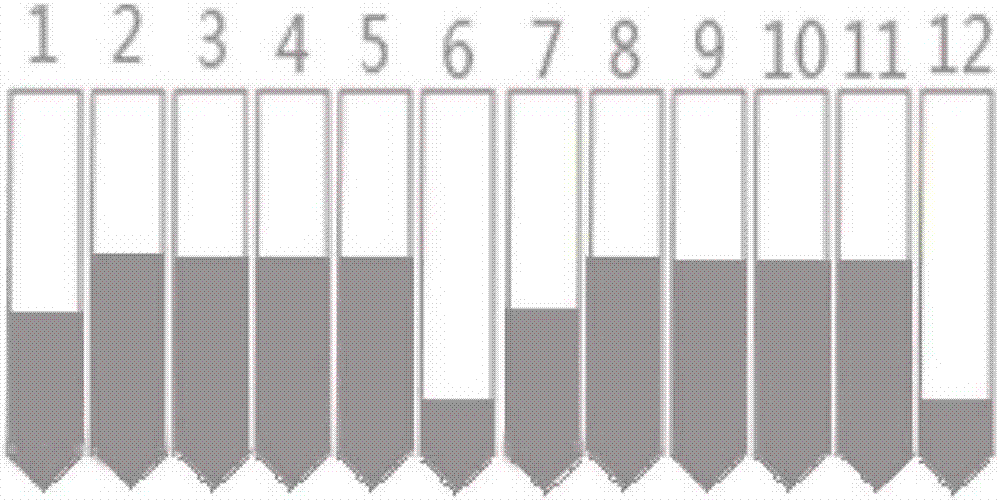Quick extraction kit for blood sampling card
A kit and blood collection card technology, which is applied in the field of rapid extraction kits for blood collection cards, can solve problems such as unstable extraction efficiency, and achieve the effects of reduced manual operation time, simple operation, and uniform components
- Summary
- Abstract
- Description
- Claims
- Application Information
AI Technical Summary
Problems solved by technology
Method used
Image
Examples
Embodiment 1
[0030] Embodiment 1: A kind of preparation method of quick extraction kit of blood collection card:
[0031] a. Preparation of blood slice digestion solution: first add Tris-HCl (pH 4.4) with a concentration of 1mol / L to the volumetric flask; after the Tris-HCl is mixed evenly, add EDTA (pH 8.0 ); after mixing EDTA, add NaCl with a concentration of 0.1mol / L; after mixing NaCl, add SDS with a concentration of 20g / L, and add sterile water to the required volume.
[0032] b. The selected concentration of tris(2-carboxyethyl)phosphine is 0.5 mol / L.
[0033] c. Configuration of the lysate: first add the guanidine isothiocyanate taken by weighing in the volumetric flask, add the Tris-HCl with a concentration of 12mmol / L and a pH of 3.2; add the sodium hydroxide with a concentration of 4.5mmol / L; After the guanidine isothiocyanate is completely dissolved, add NP-40 with a concentration of 6% and mix well; after the NP-40 is mixed well, add SDS with a concentration of 2% and mix well...
Embodiment 2
[0041] Embodiment 2: A kind of preparation method of blood collection card rapid extraction kit:
[0042] a. Configuration of blood slice digestion solution: first add Tris-HCl with a concentration of 3mol / L (pH 3.2) into the volumetric flask; after the Tris-HCl is mixed, add EDTA with a concentration of 0.8mol / L (pH10.0 ); after the EDTA is mixed, add NaCl with a concentration of 0.3mol / L; after the NaCl is mixed, add SDS with a concentration of 40g / L, and add sterile water to the required volume.
[0043] b. The selected concentration of tris(2-carboxyethyl)phosphine is 0.8 mol / L.
[0044] c. Configuration of the lysate: first add the guanidine isothiocyanate weighed in the volumetric flask, add Tris-HCl with a concentration of 14mmol / L and a pH of 2.8; add sodium hydroxide with a concentration of 2mmol / L; After the guanidine thiocyanate is completely dissolved, add NP-40 with a concentration of 10% and mix well; after the NP-40 is mixed well, add SDS with a concentration o...
Embodiment 3
[0052] Example 3: Application of a blood collection card rapid extraction kit
[0053] Take the blood collection card as the sample, first adjust the dry bath to 56°C, then cut the entire blood spot on the blood collection card into pieces, and transfer the pieces to 1.5ml EP tubes. Then add 400 μl of blood slice digestion solution and 50 μl of tris(2-carboxyethyl)phosphine, shake and mix well, place in a warm bath at 56°C for 1 hour, and mix well every 15 minutes. Finally, it was centrifuged at 12000 rpm for 1 min, and 200 μl of supernatant was extracted as a test sample.
PUM
 Login to View More
Login to View More Abstract
Description
Claims
Application Information
 Login to View More
Login to View More - R&D
- Intellectual Property
- Life Sciences
- Materials
- Tech Scout
- Unparalleled Data Quality
- Higher Quality Content
- 60% Fewer Hallucinations
Browse by: Latest US Patents, China's latest patents, Technical Efficacy Thesaurus, Application Domain, Technology Topic, Popular Technical Reports.
© 2025 PatSnap. All rights reserved.Legal|Privacy policy|Modern Slavery Act Transparency Statement|Sitemap|About US| Contact US: help@patsnap.com



